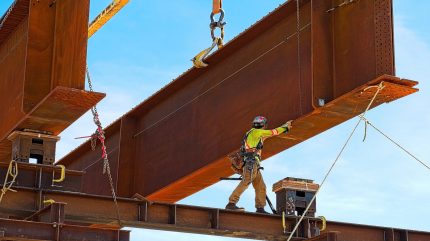
Canada has announced the introduction of a tariff rate quota to shield its domestic steel industry from international pressures.
Effective from 1 August 2025, the quota will apply to countries with which Canada has free trade agreements, excluding the US and Mexico.

Discover B2B Marketing That Performs
Combine business intelligence and editorial excellence to reach engaged professionals across 36 leading media platforms.
For countries that do not have free trade agreements with Canada, the government has reduced the tariff-free quota to 50% of the 2024 volumes, down from 100%. Imports exceeding this quota will also incur a 50% tariff.
In response to the domestic industry’s concerns about becoming uncompetitive due to US tariffs, Canada will also implement additional 25% tariffs on steel imports containing materials melted and poured in China before the end of July.
These measures are intended to enhance the competitiveness of Canadian steel producers by safeguarding against trade diversion in a rapidly evolving global steel market, strengthening supply chains and attracting new private investment in Canadian production.
Furthermore, the Canadian Government is investing C$70m in Labour Market Development Agreements to provide training and income support for up to 10,000 steel workers affected by industry changes.

US Tariffs are shifting - will you react or anticipate?
Don’t let policy changes catch you off guard. Stay proactive with real-time data and expert analysis.
By GlobalDataThis investment aims to reskill the workforce and ensure it has the necessary support to meet the future demands of the steel industry.
Prime Minister Mark Carney said: “Our steel industry will be central to Canada’s competitiveness, our security and our prosperity.
“As Canada moves from reliance to resilience, Canada’s new government is taking a series of major measures to support, reinforce and transform the industry to be more resilient in the face of profound shifts in global trade and supply chains.”
Canada is also allocating C$1bn to the Strategic Innovation Fund.
This funding is intended to help steel companies undertake projects that will boost their competitiveness, encourage the production of new steel products not currently manufactured in Canada and create job opportunities, particularly in the defence sector.
To assist small and medium-sized steel enterprises facing liquidity issues, the Business Development Bank of Canada is improving its Pivot to Grow initiative.
Additionally, the steel industry is set to receive C$150m as part of the government’s Regional Tariff Response Initiative, which will be managed through Regional Development Agencies.
The Large Enterprise Tariff Loan programme is also being updated to be more inclusive and offer more affordable financing options to steel companies.
Minister of Finance and National Revenue François-Philippe Champagne said: “Our government continues to defend Canadian workers, businesses and investments as we navigate the new trading environment.
“At the same time, we are actively strengthening our domestic producers through the significant additional supports announced today, enabling them to build essential infrastructure and ensure the prosperity of workers throughout this key Canadian industry.”
In March, the Canadian Government announced plans to extend the mineral exploration tax credit for an additional two years to support the country’s mining sector.
Navigate the shifting tariff landscape with real-time data and market-leading analysis. Request a free demo for GlobalData’s Strategic Intelligence here.





